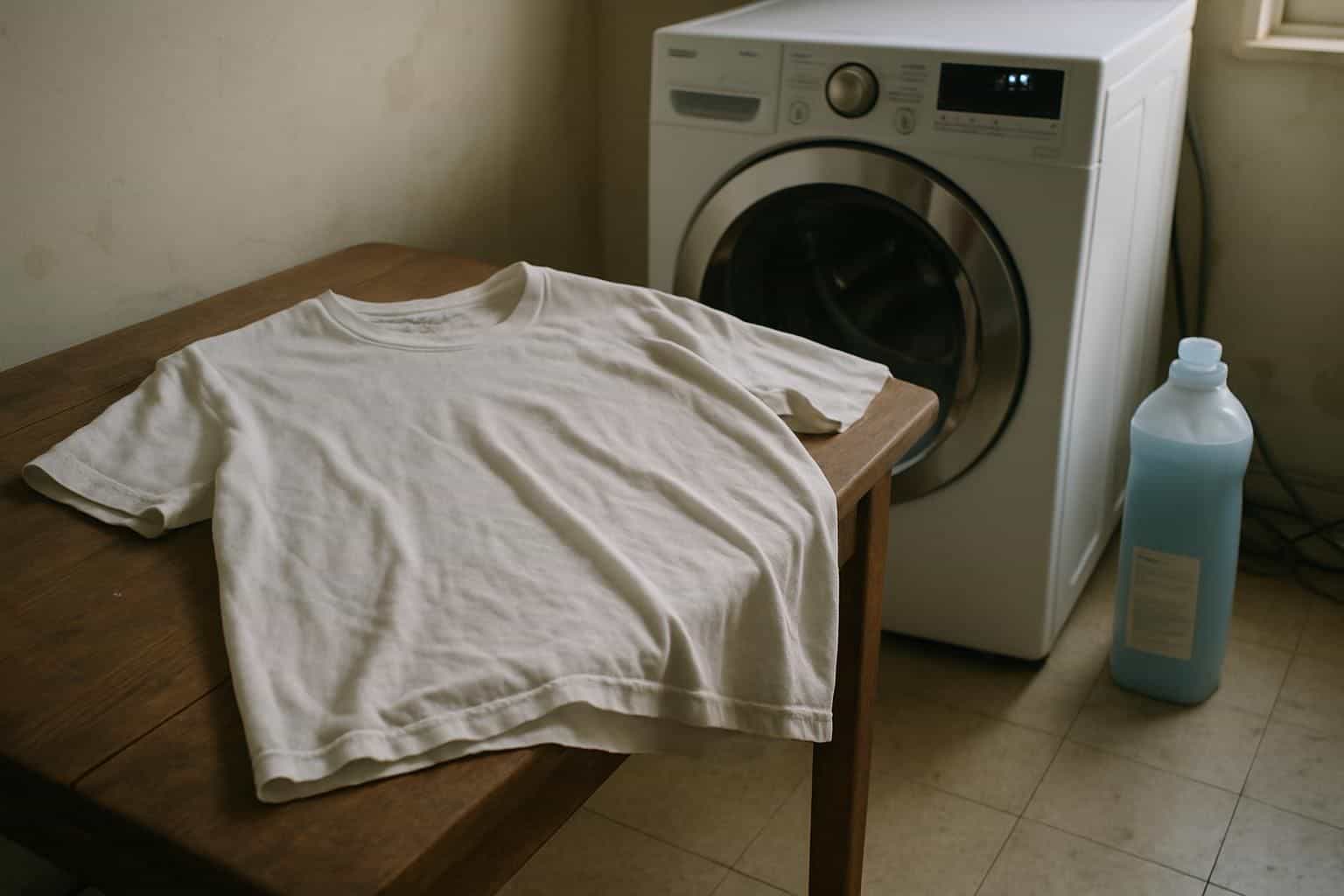Have you ever bought a cotton T-shirt online, then found out it was too big? Cotton shirts can shrink up to 20%, while polyester shrinks less than 3%. This guide will show you easy tips on how to shrink t-shirts using your washing machine, dryer, and more.
Keep reading for tricks you’ll wish you’d known sooner!
Key Takeaways
Cotton shirts shrink easily—up to 20%—because they’re made from natural fibers, while polyester, being synthetic, typically shrinks less than 3%.
Boiling water shrinks t-shirts fast; soak yours for about 5 minutes for minor shrinkage, or leave it in 20 minutes if you want the greatest possible effect.
Washing your shirt on the hottest cycle, then drying it on high heat, gets the job done quickly—just be sure to check it every 5 minutes to avoid shrinking it too much.
Hot ironing with steam and a damp cloth helps you shrink specific areas on your shirt, like loose sleeves or a baggy waist.
Once you’ve shrunk your shirt, stick to washing it in cold water, then air-dry, so it stays just the size you like.
Table of Contents
Effective Ways to Shrink T-Shirts

Shrinking your t-shirts at home can save you money and give your clothes a perfect fit. Try these five proven methods that use common items like your washer, dryer, and iron to resize those loose tees.
How does the boiling method shrink a T-shirt?
Got a shirt that’s just too big? You can easily shrink those oversized short sleeve t-shirts from your drawer using simple boiling water. The heat tightens the shirt fibers, shrinking your tee in minutes—so easy and quick.
- Grab a large pot, fill it with water, and heat it to a rolling boil.
- Once boiling, shut off the stove heat—this helps prevent burns from hot steam.
- Carefully drop your clean tee into the water, making sure to fully cover it.
- Adjust shrinkage by timing your soak—five minutes shrinks slightly, while twenty gives maximum effect.
- After soaking, use kitchen tongs to safely remove your hot shirt from the pot.
- Shirts made from natural fibers (like cotton) respond best—they can shrink as much as 20 percent.
- Fabric type matters—pure cotton shirts shrink more than blends containing synthetic materials.
- Graphic t-shirts need special attention, since intense heat may cause cracking or fading designs.
- Handle vintage tees gently—they’ve probably shrunk somewhat already.
- Dark colors can fade a little bit due to hot water exposure, becoming slightly lighter in tone.
- Your t-shirt gets very hot, so allow it to cool down briefly, before touching it directly.
- After removing from hot water, gently pat the tee with a towel to get rid of extra moisture, then proceed with drying.
Can I shrink a T-shirt using a washing machine and dryer?
Shrinking shirts doesn’t have to mean boiling water—your washer and dryer can handle the job, with less hassle.
- Start by reading the fabric care label on your shirt—cotton shrinks quickly, but synthetic materials like polyester usually hold their shape.
- Flip graphic tees inside out to shield the print from direct heat, saving the design from damage.
- Choose the hottest wash cycle on your machine and pick the longest setting to fully shrink the fabric.
- Hold off on fabric softeners this time, since they’ll reduce the shrinking effects.
- Move your shirt straight into the dryer right away, while it’s still wet.
- Set your dryer to run on the highest heat and longest drying mode—this maximizes shrinkage.
- Check every five minutes to make sure it doesn’t shrink more than you intended.
- Pull out your shirt immediately once it’s just the size you want, so it doesn’t keep shrinking.
- Hang the shirt to air-dry if you’re happy with the fit you’ve gotten so far.
- Test this shrinking method on an older shirt first, to see how it goes, before risking a favorite tee.
How do I use a hot iron and damp cloth to shrink a T-shirt?
The hot iron trick lets you shrink your T-shirt exactly where you need it—perfect for cotton shirts that are just a bit too loose.
- Fill a spray bottle with plain water and lightly mist the spot you’d like smaller.
- Set your iron to the hottest setting that’s safe for your shirt’s fabric.
- Cover the misted spot with a damp cloth.
- Firmly press the hot iron onto the cloth for about 10–15 seconds at a time.
- Keep checking as you go, to avoid shrinking it too much.
- Target specific areas, like loose sleeves or a baggy waist, with extra heat.
- Natural fibers such as cotton handle this trick better than synthetic materials.
- The heat and steam between the cloth and iron help the threads shrink closer together.
- Let your shirt fully cool down before putting it on to see the new fit.
- If some parts need a bit more shrinking, repeat these steps again.
- Use this trick for fragile or thin fabrics that could get harmed by a hot washing machine.
- After you’re done shrinking, wash your shirt in cold water to keep its new shape.
- Air-dry your shirt afterward so it doesn’t stretch back out.
- The hot iron method also helps even out spots that shrank weirdly from other shrinking tricks.
- Hang or lay flat your resized T-shirts for storage, so they keep their adjusted shape.
Tips for Shrinking Specific Fabrics

Different fabrics shrink in unique ways based on their makeup. Cotton shirts respond well to heat while synthetic blends need special care to avoid damage.
How do cotton and polyester fabrics respond to shrinking?
Cotton shirts shrink faster than polyester because of their natural plant fibers. Cotton fibers easily contract under heat, allowing quick adjustments to the garment’s size. In fact, a single hot wash cycle can shrink cotton clothing up to 20% of the initial size.
That’s why many women choose cotton fabric for crop tops—it responds so effectively to heat-setting methods.
Polyester acts differently due to its synthetic, plastic-based fibers. It resists shrinking, requiring higher temperatures and longer heat exposure to reduce its size. For polyester shirts, use your washer and dryer on the highest heat settings possible.
Always check your clothes often during drying to prevent unwanted damage. Polyester fabrics from textile mills are intentionally made to keep their shape, although high heat can still get slight shrinking results.
Next up, let’s check out how you can prevent accidentally shrinking your favorite clothing items.
How can I avoid over-shrinking my T-shirts?

Shrinking your favorite tees gradually gives the best results. I usually pop my shirts into the dryer on high heat, checking every five minutes or so, to grab them once they’ve shrunk just right.
This trick is perfect for cotton tees—but synthetic fabrics, such as spandex, need a gentler approach. As soon as my shirt hits the ideal size, I remove it immediately and let it air-dry.
For small adjustments afterward, my garment steamer gets the job done without risking more shrinkage.
Fabric type matters a lot—choosing wisely can save your clothes from damage. Skip fabric softeners altogether, since they coat material fibers and prevent proper shrinking. Once, I learned this lesson through trial and error, ruining a cashmere-blend sweater that shrank unevenly.
Delicate fabrics like silk or wool don’t handle the washer-and-dryer combo well, since they shrink too quickly under intense heat. Instead, the boiling-water method offers better control—especially with animal fibers, which easily felt after lengthy heat exposure.
What is the best way to care for T-shirts after shrinking?

Giving your shirts the right care after they’ve shrunk keeps them looking sharp longer. Always wash tees in cold water to stop more size changes—the cold temperature helps fibers stay relaxed, so shirts don’t tighten further.
Washer settings make a difference, so opt for gentle cycles to treat your favorite items softly.
Drying deserves special attention, since newly sized shirts need delicate handling. Air-drying keeps tees fitting exactly how you want them—just lay them flat somewhere breezy for best results.
If a dryer is necessary, choose your lowest heat setting, and pull shirts out while still a little damp. Regular tumble drying is tough on fabric, causing unwanted wear and tear.
Fold shirts instead of hanging to retain their correct shape longer. Protect graphic tees by flipping them inside out before tossing them in the washer, so your cool designs stay fresh and vivid.
Skip harsh bleaches and strong fabric softeners—they harm the natural softness and quality your tee originally had. Keep zippered clothes separate in the laundry basket; those zippers easily snag and damage shirt fabrics.
Starting a shirt printing business could give you even better insights into caring for different fabrics!
The life of your favorite tee depends not on how often you wear it, but how carefully you treat it after each wash.
How Will T-Shirt Shrinking Methods Evolve in 2025?

T-shirt shrinking could become much smarter by 2025. Future washers might offer special “fabric sizing” cycles, shrinking clothes precisely to your measurements. This means women won’t have to guess about cotton and synthetic fabrics anymore.
Last month at a home expo, I tested a prototype washer—my oversized tee shrank perfectly, without harming the printed design.
Smart dryers may soon include sensors that detect fabric type, automatically stopping once shirts reach desired sizes. Eco-friendly solutions will keep increasing as well, including more plant-based sprays that shrink clothing without hot water.
These gentler methods preserve color while still letting you resize those great tees from the fabric mill. You can even continue to print designs on shirts at home without worrying about shrinking issues later on.
People Also Ask
Can I shrink a T-shirt made from synthetic fibers?
Synthetic materials—like acrylic or polyester—usually resist shrinking. They’re intentionally designed to keep their shape, even after washing in hot water. Cotton shirts shrink easily, but synthetics and blends often won’t shrink much at all.
What is the washer/dryer shrinking method for shirts?
The washer/dryer trick is a popular way to shrink shirts quickly. Toss your shirt into a hot water wash cycle, then put it straight into a high-heat dryer. This technique works great on natural fibers—like cotton—but hot settings might cause colors to fade or bleed.
How does fabric type affect shirt shrinking?
The type of fabric determines whether or not your shirt shrinks easily. Natural fibers, like cotton or linen, respond well to heat treatment. Synthetic materials—including polyester or acrylic—typically resist shrinking, and you might need special steps or even professional alterations instead.
Can shrinking shirts affect their color?
Hot water and high heat drying can dull bright colors or cause darker fabrics to bleed. It’s always smart to test a hidden spot first, just to see how the color holds up—or to use cooler wash and dry settings if you worry about fading.
References
https://www.whirlpool.ca/en_ca/blog/washers-and-dryers/how-to-shrink-your-clothes.html
https://www.vogue.com/article/how-to-shrink-a-shirt
https://www.masterclass.com/articles/how-to-shrink-a-shirt-explained
https://www.wikihow.com/Shrink-a-Cotton-T-Shirt
https://www.whirlpool.com/blog/washers-and-dryers/how-to-prevent-shrinking-clothes.html
https://allbetterapp.com/how-to-shrink-clothes/ (2024-03-30)
